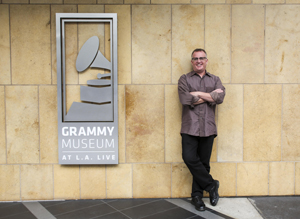
After a 35 percent increase in attendance at downtown L.A.’s Grammy Museum this year, the music gallery is taking its act on the road though a series of licensing deals that will bring a dozen of its past and future exhibits to other institutions around the world.
There are also plans to open three or four other Grammy Museums across the country – the first set for Mississippi in March.
“We’re proud of where we are today and excited about where we will be tomorrow,” said Bob Santelli, who has been executive director of the nonprofit since it opened in 2008 at L.A. Live.
While the National Academy of Recording Arts and Sciences was involved in its creation, the museum operates apart from it. The museum licensed the Grammy name for an undisclosed price from the academy ahead of its opening. The attraction is operated by L.A.’s Anschutz Entertainment Group, which runs several other venues at the L.A. Live complex.
After a hugely successful Taylor Swift exhibition, the museum’s new main attraction is a display devoted to the life and career of icon Frank Sinatra.
The museum’s growing popularity has been a boon to downtown L.A. businesses, said Ernest Wooden Jr., president of the Los Angeles Tourism & Convention Board.
“Quintessential L.A. experiences such as the Grammy Museum help make us the undisputed entertainment capital of the world and have helped spark downtown’s recent revitalization as a popular destination for visitors from all over the globe,” said Wooden.
The Grammy Museum would not reveal revenue or specific attendance numbers, but Santelli claimed admissions have risen year over year.
Growing Grammy
Though the Grammy Awards will always be connected to Los Angeles, Santelli and the museum’s board have decided the brand is ready for a bigger stage.
In March, a second Grammy Museum will open its doors on the campus of Delta State University in Cleveland, Miss. Having drawn financial support from the federal government and the state of Mississippi, the facility will replicate the L.A. site’s exploration of the past, present and future of all music, but have a particular emphasis on blues artists hailing from that region.
Santelli said the Mississippi museum will pay a licensing fee to the L.A. organization to use its name and content. There are also plans to open as many as three more museums in the next seven years under similar arrangements, but he declined to disclose which cities are in the mix.
Other museums are trying to cash in on the lure of Grammy, too.
Museums as wide-ranging as the Beatles Story in Liverpool, England; the Woody Guthrie Center in Tulsa, Okla.; and the Lyndon Baines Johnson Library and Museum in Austin, Texas, are displaying various exhibits from the downtown L.A. facility – also in exchange for a licensing fee.
Chris Morrison, the museum’s traveling exhibitions manager, said the licensing revenue will be used to help bring more local kids to the museum by bus.
“As a nonprofit, education is a main goal here and with so many music programs dropped by schools, we fill the gap by opening up young ears and minds to the importance of music,” said Morrison.
The Sinatra exhibit was curated by the late singer’s granddaughter, Amanda Erlinger, an artist who lives in Laguna Beach. She said the museum’s commitment to music education was a key factor in her decision to participate.
“I don’t normally like to be in the spotlight but wanted to support the Grammy Museum largely because it puts the emphasis on education,” Erlinger said. “I think this exhibit teaches everyone an important lesson my grandfather believed in – that you should love life and never give up on your dreams.”
Morrison said that the extra revenue could also lead to the recruitment of additional staff. He noted that the museum employs 28 people – a number much smaller than comparable facilities around the country.
Different demographics
Things weren’t always so rosy. In its early days, the museum was forced to lay off a number of staff due to a shortage of guests.
“I think the biggest business lesson I’ve learned here is never open a museum during a recession,” explained Santelli. “But we’ve come a long way since 2008 and play to different demographics. The success of our recent Taylor Swift and Tupac Shakur exhibits proved that.”
Santelli said he hopes the Sinatra exhibit will appeal not just to baby boomers but also the hipster community in Los Angeles and beyond.
He said the biggest change in recent years has been an increase in visitors from abroad as oversees tourists flock to check out the thriving downtown arts-and-culture scene.
Admission to the museum is $12.50 and memberships – which allow unlimited visits and access to special member events – start at $60 a year.
Grammy-nominated L.A. composer Mac Quayle, who writes the scores for both Fox’s “Scream Queens” and FX’s “American Horror Story,” said the Grammy Museum offers a vital service in showcasing music’s place in society.
“I find it exciting that the expansion to new locations means exhibits are now available to so many more people,” said Quayle. “My life has been dedicated to music and it’s inspiring to know that here in Los Angeles there’s an organization constantly improving the ways it presents the work of music creators all over the world.”
